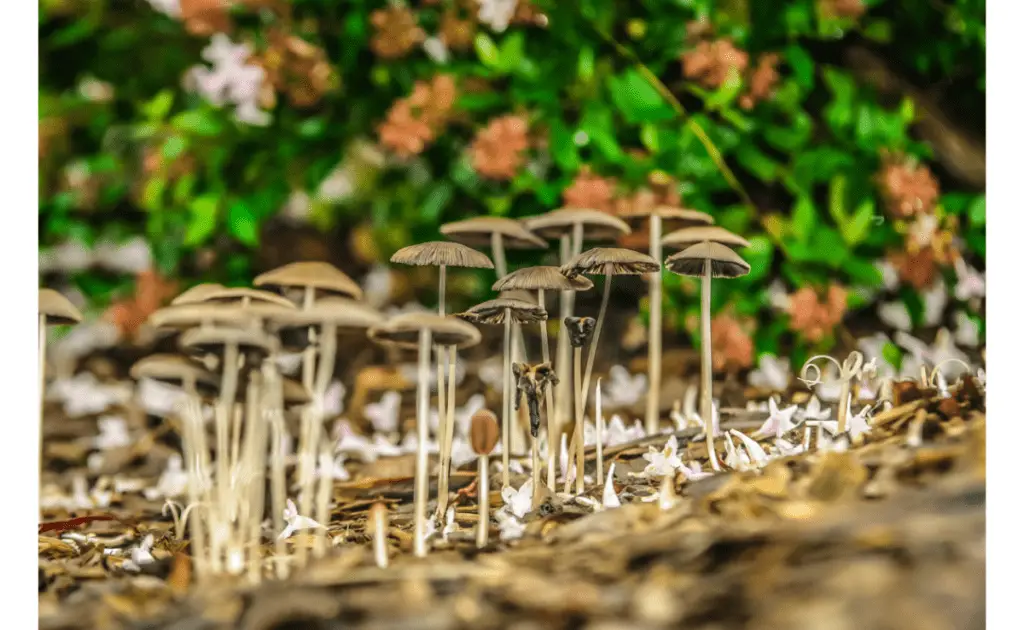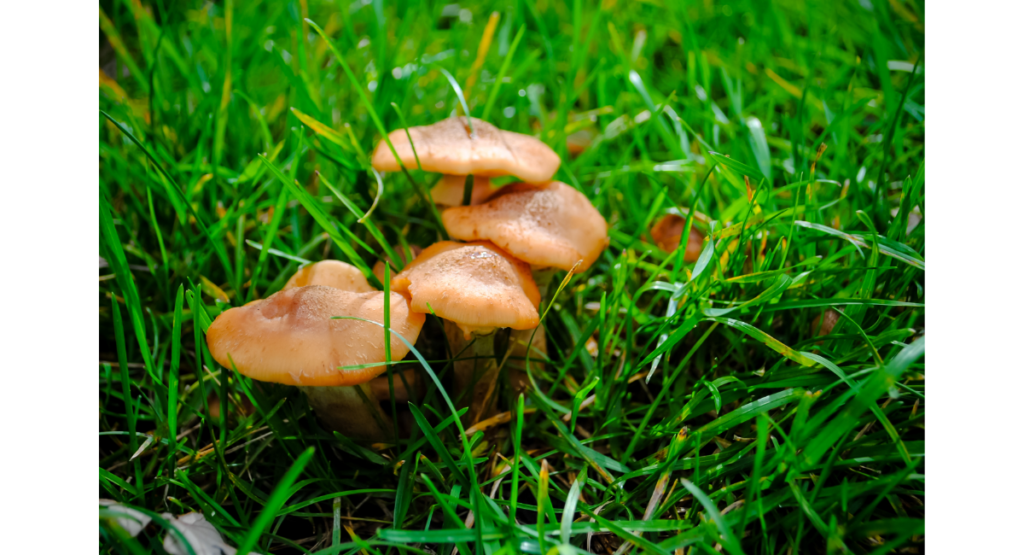
Fungi send up reproductive structures in response to long periods of humid weather. Windblown spores help fungi spread to new regions. When spores fall in a suitable spot, they grow into young fungi, which, given sufficient time, will create mushrooms. So now you must be thinking why mushrooms are growing in my garden?
The most essential thing to remember about mushrooms is that they are the fruiting structures of soil-dwelling fungi. Most of the fungal bulk is hidden beneath the earth, where it stays undetected until mushrooms appear. Fungi, for the most part, are helpful. They are byproducts that decompose organic debris that is dead or decaying, like stumps, old stems, or leaves. Most fungi do not harm grass or plants; they are merely an eyesore.
Is It Bad if Mushrooms Are Growing in My Garden?
The truth is that mushrooms in the yard are good in general. The mushroom you observe is a small part of a bigger fungal system that exists in all living dirt at all times. Yes! Dirt is alive and well!
And whenever you observe a mushroom grow, it means that the fungus is reproducing. To put it another way, it propagates by releasing spores from a mushroom. The spores eventually turn into new mushrooms in the area. Once the climate dries out, the fungi will vanish on their own. Remember that the fungal mycelia are still developing in the ground, even when the mushroom has vanished.
As long as there is enough organic stuff to feed on, the fungus will proceed to develop and flourish. Mushrooms will reappear as soon as the developing circumstances are favorable, which could take another year. You can clear mushrooms manually or with a mower if you don’t want to wait for them to disappear. Although destroying the mushrooms has no effect on the fungus in the ground, it does limit the number of spores discharged into the surroundings and the number of new mushrooms in various regions of the lawn or garden. Fungicides are often avoided since they are inefficient and mushrooms aren’t harmful in the first place.
It’s worth noting that a lot of mushrooms are toxic. Never consume an unidentified mushroom unless you’re sure of your ability to identify it. If you end up eating wild mushrooms, proceed with caution and start with a modest amount. Even ostensibly edible mushrooms may make most people quite sick.
Can I Grow Mushrooms in My Garden?
There’s no reason to be clueless when it comes to mushroom cultivation. These delightful food species are highly nutritious: they’re fat-free, high in nutrients and other minerals. Creating the correct growing settings and obtaining mushroom spawn, which is the substance used to reproduce mushrooms, are the two most important aspects of cultivating mushrooms at the house. Plant oyster mushrooms, portobellos, and more in your yard.
To be clear, observing the buds of fungi can be a warning indication that things aren’t quite right.
If a tree develops shelf fungus, for example, it’s time (or more than likely past time) to consult an arborist about the tree’s health. That’s since shelf fungi only start producing fruiting bodies after they’ve consumed a large portion of the tree.
In most circumstances, fungus seeks out organic matter that is already dying or decaying. When it comes to living plants, like a large tree, however, that plant is most certainly on the way out.
In the wild, a wide variety of mushrooms can be found, and most of these can be grown at home (except for morels, which only appear in nature). Planting your mushroom types rather than wild-harvesting them has the advantage of ensuring you don’t pick a toxic mushroom. Indoors, you can cultivate cremini, enoki, maitake, and white button mushrooms, but everyone has its growing requirements. For more tips on gardening indoors, check out this post.
What to Do if Mushrooms Grow in Your Garden?
Because a fungus isn’t causing problems in the yard doesn’t mean it won’t lead to problems for you or your animals if you eat it. And, because mushroom classification is difficult, it wouldn’t be good to inform you if you have a tasty fungus growing in the yard. Many mushrooms that grow in the garden are hazardous.
However, if you aren’t skilled, determining which are safe and which aren’t can be a dangerous game. So don’t even consider eating them if you’re completely positive you understand what you’re choosing.
Certain mushrooms make you unwell right quickly, while others take several days to irreversibly harm the internal organs. (You may not realize you’re ill until it’s too late to recover).
Mushrooms occur in a variety of shapes and sizes. From wiggly jelly rounds to puffballs, there’s something for everyone. Some of them resemble cascading beards. Some types grow on top of other mushrooms and consume them. Some resemble barfy technicolor piles.
Mushrooms need moisture to grow fruit, but because they don’t have skin, water is easily lost. As a result, mushrooms require a high humidity atmosphere to prevent water loss. It is easy to “drown” a mushroom since they breathe and transfer gases into the air. The soil should be damp, not wet while growing mushrooms inside. When the climate is hot, wild mushrooms that are growing outside vanish, but they may reemerge when the water and humidity level rise. Many mushrooms can be found on trees, decaying leaves, manure, or compost, where they rely on the waste or decaying stuff.
Where Do Mushrooms Grow Best?
The first step in mushroom cultivation at home is to select the type of mushroom to cultivate. Shiitake mushrooms and white button mushrooms are some of the most common mushrooms to cultivate at home. Purchase spores or spawns of the fungus you want from a reliable seller.
Maybe it’s a touch old style, but the worth of a well-written and thorough text is still difficult to surpass. Learning from the tribulations of the best in the field, and avoiding wasting time and money on cultivation techniques and trials that aren’t going to succeed.
It can make a big difference to have the correct equipment for the task. Mushroom cultivation necessitates the use of specialized procedures and tools that are frequently incompatible with makeshift substitutes.
You can begin to investigate and develop your method of doing stuff once you’ve learned to grow and learned what works. When you’re first starting, however, it’s important to stick with what has been proven to work.
The basic stages for mushroom cultivation remain the same once you’ve decided the species you’ll be cultivating and have found the preferred cultivating medium. Mushroom cultivation at home necessitates a cool, gloomy, and damp environment. This is often done in a basement, but it can be done in an underused cupboard or closet – anyplace you can generate near darkness and regulate humidity levels.
Measure the temperature of your growth area before you start producing. Most mushrooms thrive at conditions between 55 and 60 degrees Fahrenheit, away from sunlight and draughts. Cooler weather, around 45F, is preferable for enoki mushroom growth. Mushroom cultivation is a fantastic winter project since many basements become too hot in the summers for perfect circumstances.
Although mushrooms accept little light, the location you select should be primarily quiet or in low-light conditions. If you decide to cultivate mushrooms in the basement, keep them in a cupboard where they will not be disturbed. Certain mushroom species can still be grown outside in prepared soil or logs, but this takes significantly longer (6 months – 3 years) than in controlled conditions.
Why Do Mushrooms Develop in a Vegetable Pot?
Every gardener will be surprised to find mushrooms sprouting in their vegetable pots. But don’t be concerned. Mushrooms are a common sight in vegetable plant containers, and they are a sign of good things to come. Mushrooms in the yard indicate that the soil is in good shape.
Fungi are what mushrooms are. They don’t have conventional roots. This means they can’t eat in the same manner that plants can. Mushrooms must connect themselves to the stems of the vegetables or rely on the minerals in the soil to eat. As a result, if mushrooms are flourishing in your veggie pots, you may be confident that the soil is nutrient-rich.
Is There a Use for These Mushrooms?
Mushrooms blooming in the soil indicate that it is nutritious, but do the mushrooms have another function? As they eat, grow, and disintegrate, these fungi aid your vegetation by sharing minerals with the earth.
The term fungus has a bad meaning, but that does not suggest it is always nasty. Mushrooms aren’t the same as mold. They won’t hurt or damage the plants. Mushrooms develop, feed on your soil, and then disintegrate, leaving more soil nutrients. Mushrooms and food plants share a symbiotic interaction. You don’t have to keep mushrooms in the yard if you don’t want them. The plants will not be harmed if you remove them from the ground.
What Causes Mushrooms to Grow in The Vegetable Pots?
When people notice mushrooms in the pot, some gardeners wonder, “How did the mushrooms come there?” Rather than seeds, mushrooms multiply by spores. They produce spores, which are microscopic structures that make the gene sequence for reproducing the mushroom. Spores do not need to be planted; instead, they are discharged into the atmosphere and transported by the air to locate a suitable location to germinate.
Fungal spores are dispersed in enormous numbers to locate and connect to a food source. Most spores never find a source of nutrients to thrive, which is why most are discharged from good mushrooms.
How to stop mushrooms growing in garden- prevent mushrooms and fungi
To remove and prevent mushrooms from growing in your garden or lawn you have to remove what it wants. Unfortunately your lawn and gardens want the same soil conditions as mushrooms growing. Moist and rich soil. To reduce mushrooms growing try these 3 things.
- Reduce water yard mushrooms need water try reducing watering by a few minutes a week and see if that doesn’t help it may take some time to dry out and stop mushroom growth. Check soil moisture levels as part of your lawn care.
- Let the soil dry out on hot days. Mushrooms can not stand dry conditions short spurts of dry soil can help reduce the numbers.
- Spray with a anti fungi made to get rid of backyard mushrooms. Be careful not to apply sprays that will harm your grass or plants.
Why are brown mushrooms growing in my lawn, soil and plants

Mushrooms love rich organic matter same as plants. Yard mushrooms are no different they all want moist rich soil which is a sign you have good soil. Garden mushrooms are the same way your plants and vegetables need a warm wet environment mushrooms grow in warm wet areas. Do not worry about mushrooms. Now I know some people do not want to see lawn mushrooms. Depends where you live you may be able to remove them.
